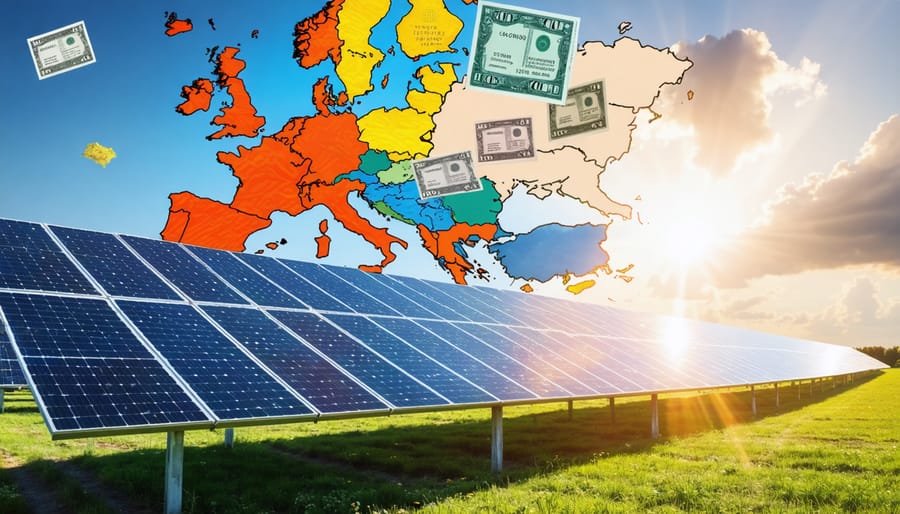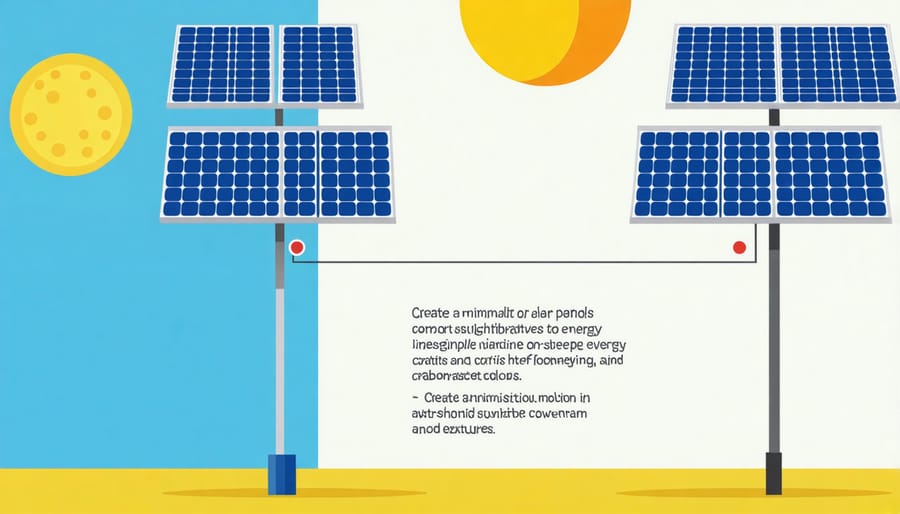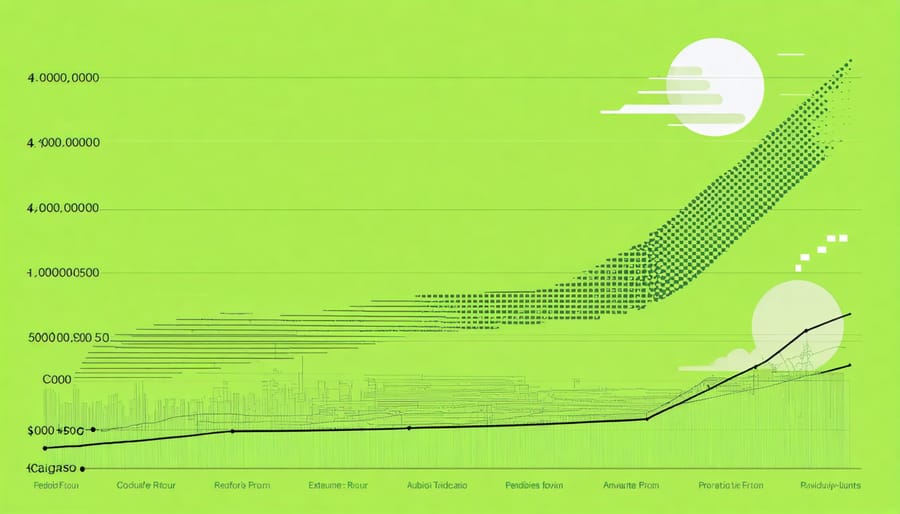Carbon Credits Transform Solar Projects Into Double Investment Winners

Transform your solar energy investment returns into a dual revenue stream by strategically entering the carbon credit market. As Europe’s carbon trading system expands and prices surge past €90 per tonne, investing in carbon credits has emerged as a compelling opportunity for sustainability-focused investors and solar asset owners.
Carbon credits generated through solar installations now command premium valuations, particularly in the EU Emissions Trading System (EU ETS), where strict verification protocols and growing corporate demand drive consistent market growth. For every megawatt-hour of clean energy produced, solar installations can generate tradeable carbon credits that offset approximately 0.5 tonnes of CO2 emissions.
Forward-thinking investors are capitalizing on this opportunity by combining traditional solar revenue streams with carbon credit trading, effectively doubling their potential returns while contributing to Europe’s ambitious climate goals. This market’s structured approach to environmental commodities provides a transparent, regulated pathway for monetizing the environmental benefits of solar investments, with projected market growth exceeding €200 billion by 2030.

How Solar Projects Generate Carbon Credits
Carbon Credit Calculation Methods
Carbon credit calculations for solar installations follow standardized methodologies recognized by international carbon markets. The primary formula considers the amount of carbon dioxide emissions avoided by generating clean solar energy instead of using fossil fuel-based power sources.
The basic calculation involves multiplying the total kilowatt-hours (kWh) of electricity generated by the solar installation by the grid emission factor (GEF) of the region. For example, if a solar system produces 10,000 kWh annually and the local GEF is 0.5 kg CO2/kWh, the carbon credits generated would be 5 metric tonnes of CO2 equivalent per year.
Additional factors that influence calculations include:
– System efficiency and performance ratio
– Solar radiation at the installation location
– Technical losses in power transmission
– Baseline emissions scenarios
– Monitoring and verification protocols
European carbon credit certification bodies require detailed documentation of these calculations, including:
– Independent third-party verification
– Regular monitoring reports
– Equipment calibration records
– Grid connection data
– Historical generation data
The methodology must comply with internationally recognized standards such as the Clean Development Mechanism (CDM) or Verified Carbon Standard (VCS) to ensure credibility and tradability of the generated carbon credits.
Verification and Certification Process
The verification and certification of carbon credits from solar projects follows a rigorous multi-step process to ensure credibility and market value. Initially, project developers must document baseline emissions and calculate potential carbon reductions using internationally recognized methodologies, such as those established by the Verified Carbon Standard (VCS) or Gold Standard.
Independent third-party verification bodies conduct thorough on-site assessments to validate the project’s emission reduction claims. These auditors examine technical specifications, monitoring systems, and operational data to confirm that the solar installation meets all required standards. The verification process typically includes reviewing energy generation data, grid connection records, and displacement of fossil fuel-based power.
Once verified, projects receive certification from authorized bodies, enabling the issuance of carbon credits. Each credit represents one metric tonne of CO2 equivalent avoided. The certification process includes regular monitoring and reporting requirements to maintain compliance. Project owners must submit periodic verification reports, typically annually, to demonstrate continued emission reductions.
European solar projects benefit from the region’s robust certification frameworks and established carbon markets. The EU Emissions Trading System (EU ETS) provides additional validation pathways, though requirements vary based on project scale and location. Maintaining detailed documentation throughout the project lifecycle is essential for successful certification.
European Carbon Credit Markets
EU Emissions Trading System (EU ETS)
The European Union Emissions Trading System (EU ETS) stands as the cornerstone of Europe’s climate action strategy and represents the world’s first major carbon market. As a crucial component of Europe’s green transformation, this cap-and-trade system covers approximately 40% of the EU’s greenhouse gas emissions, encompassing over 11,000 power stations and industrial plants across the European Economic Area.
Operating since 2005, the EU ETS works by setting a cap on total emissions and requiring covered entities to surrender allowances equivalent to their annual emissions. Companies can either receive free allowances, purchase them at auction, or trade them with other participants. The system creates a financial incentive for businesses to reduce their carbon footprint, as surplus allowances can be sold for profit.
The market’s value has grown significantly, with carbon prices reaching record levels in recent years. This price signal drives investment in clean technologies and innovative solutions. For businesses and investors, the EU ETS presents opportunities to generate additional revenue streams through strategic trading and emissions reduction projects.
The system undergoes regular reforms to maintain its effectiveness, with Phase 4 (2021-2030) introducing more stringent caps and expanded sector coverage. This evolution ensures the EU ETS continues to play a vital role in achieving the EU’s ambitious climate targets while creating valuable opportunities for sustainable investments.

Voluntary Carbon Markets
Voluntary carbon markets offer diverse opportunities for solar project owners to trade their carbon credits beyond compliance markets. These alternative platforms provide flexible trading options and often feature lower entry barriers, making them accessible to a broader range of participants. Notable European exchanges include the European Climate Exchange (ECX) and the BlueNext platform, which facilitate direct trading between buyers and sellers.
For solar energy producers, these markets present distinct advantages. Trading can occur through established brokers, online marketplaces, or direct negotiations with corporate buyers seeking to offset their emissions. Many platforms now offer digital solutions for tracking, verifying, and trading credits, streamlining the process for participants of all sizes.
The voluntary market’s growing sophistication has led to the development of specialized segments. Premium credits from solar projects often command higher prices due to their additional sustainable development benefits. European solar installations particularly benefit from the region’s robust verification standards and growing corporate demand for high-quality offsets.
To participate effectively, investors should consider factors such as market liquidity, price transparency, and transaction costs. Many platforms offer educational resources and support services to help newcomers navigate the trading process. Regular market analysis and networking with other participants can help identify the most advantageous trading opportunities while maintaining compliance with European regulations.
Maximizing Returns Through Carbon Credit Trading
Timing Your Carbon Credit Sales
Successfully timing your carbon credit sales requires a strategic approach based on market dynamics and regulatory cycles. The European carbon market typically experiences seasonal patterns, with prices often peaking during the compliance periods when companies must meet their emission reduction targets.
The most advantageous selling periods often align with quarterly reporting deadlines, particularly in March and December, when demand from industrial buyers tends to increase. However, market prices can also be influenced by broader economic factors, environmental policies, and international climate agreements.
To optimize your returns, consider implementing a staged selling strategy rather than liquidating your entire carbon credit portfolio at once. This approach helps mitigate market volatility risks while capitalizing on price peaks. Monitor key market indicators such as:
– EU ETS carbon price trends
– Policy announcements and regulatory changes
– Industry compliance deadlines
– Economic growth forecasts
– Energy market developments
Working with experienced carbon market analysts can provide valuable insights into market timing. They can help identify optimal selling windows based on technical analysis and market fundamentals. Additionally, some investors choose to participate in forward contracts, which can offer price certainty and help protect against market downturns.
For long-term investors, maintaining a portion of credits as a strategic reserve can be beneficial, especially as carbon prices are projected to rise with increasingly stringent emission regulations. Regular market assessment and flexibility in your selling strategy will help maximize the value of your carbon credit investments.
Portfolio Management Strategies
Effective portfolio management in solar and carbon credit investments requires a strategic approach to maximizing solar investment returns while optimizing carbon credit revenue streams. The key lies in understanding how these two revenue sources complement each other and implementing strategies to enhance both simultaneously.
Start by establishing clear performance metrics for your solar installation, monitoring both energy generation and carbon offset calculations. This data forms the foundation for accurate carbon credit validation and helps identify opportunities for optimization. Consider implementing smart monitoring systems that track real-time performance and automatically document carbon reduction achievements.
Diversification within your carbon credit portfolio is crucial. While some credits may be sold immediately in the voluntary market, consider holding a portion for future trading when market conditions are more favorable. This approach helps buffer against market volatility while maintaining steady revenue streams from solar energy generation.
Risk management should focus on both technical and market aspects. Regular maintenance of solar installations ensures consistent energy production and carbon offset generation. Meanwhile, staying informed about carbon market trends and regulatory changes helps in timing credit sales effectively.
For optimal results, consider partnering with carbon credit aggregators or joining collective trading schemes. These arrangements can provide better market access and potentially higher prices for your credits, while reducing administrative burden. Remember to regularly review and adjust your strategy based on market conditions and performance data.

Future Outlook and Opportunities
The carbon credit market is poised for significant growth, with projections indicating a potential market value of €1 trillion by 2030. This expansion creates compelling opportunities for solar energy investors, particularly in the European market where regulatory frameworks are becoming increasingly supportive of carbon trading mechanisms.
Several key trends are shaping the future landscape. The EU’s commitment to achieving carbon neutrality by 2050 is driving stricter emissions regulations and higher carbon prices, making solar-generated carbon credits more valuable. Additionally, the emergence of blockchain technology is revolutionizing carbon credit trading, offering enhanced transparency and reduced transaction costs while protecting solar investments through improved verification systems.
Corporate demand for carbon credits is expected to surge as more companies adopt net-zero targets. This presents an excellent opportunity for solar project owners to develop strategic partnerships with businesses seeking to offset their emissions. The voluntary carbon market, in particular, shows promise for small to medium-scale solar installations.
Innovative financing models are emerging that combine traditional solar investment returns with carbon credit revenue streams. These hybrid models can potentially increase overall project returns by 15-25%, making solar installations more attractive to investors. Furthermore, the standardization of carbon credit certification processes is making it easier for smaller projects to participate in the market.
The integration of artificial intelligence and IoT technologies is streamlining carbon credit generation and trading. These technologies enable more accurate monitoring of emissions reductions and automated credit issuance, reducing administrative burdens and increasing market efficiency.
Looking ahead, several opportunities stand out for European solar investors:
– Development of community solar projects with shared carbon credit benefits
– Integration with emerging green hydrogen initiatives
– Participation in cross-border carbon credit trading programs
– Expansion into developing markets through bilateral agreements
– Creation of bundled environmental attribute products combining carbon credits with other green certificates
To capitalize on these opportunities, investors should focus on building robust monitoring and verification systems, staying informed about regulatory changes, and developing relationships with carbon market intermediaries. Early adoption of these strategies will position solar investors to maximize returns as the carbon market matures.
Investing in carbon credits through solar energy projects presents a compelling opportunity for European businesses and homeowners to contribute to climate action while generating additional revenue streams. By understanding the fundamentals of carbon credit markets, conducting thorough due diligence, and working with reputable verification bodies, investors can effectively participate in this growing market.
Success in carbon credit investments requires a strategic approach: start by assessing your project’s potential for carbon credit generation, ensure compliance with European regulatory frameworks, and develop a clear understanding of market dynamics. Consider partnering with experienced carbon credit traders or platforms that can help navigate the complexities of certification and trading.
For maximum impact and returns, focus on high-quality carbon credit projects that deliver verified emissions reductions and contribute to sustainable development goals. Regular monitoring and reporting of your solar installation’s performance will help maintain the value of your carbon credits and ensure continued market access.
Take action by first registering your solar project with appropriate certification bodies, establishing baseline emissions data, and implementing robust monitoring systems. Stay informed about market trends and policy developments that could affect carbon credit values. Remember that while carbon credits can enhance the financial returns of your solar investment, they work best as part of a comprehensive sustainability strategy that prioritizes genuine emissions reductions and environmental stewardship.
By following these guidelines and maintaining a long-term perspective, European investors can successfully participate in the carbon credit market while contributing to the continent’s ambitious climate goals.
Leave a Reply